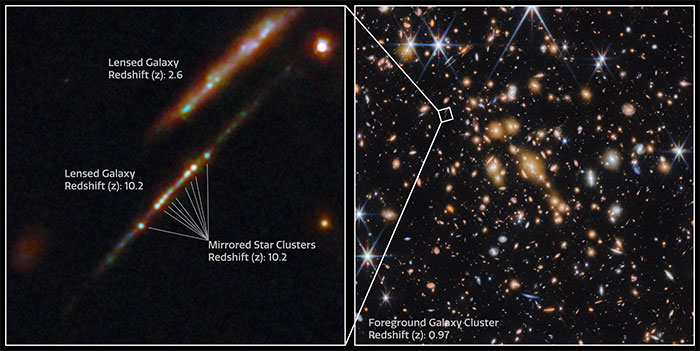James Webb Telescope Confirms 'Unexpected' Expansion Rate of the Universe
New research from NASA's James Webb telescope has confirmed a surprising discovery that the universe is expanding 8% faster than scientists previously thought.
This has raised a big question in the astronomical community: Are there some as-yet-unknown factors driving this expansion rate, especially mysterious ones like dark matter and dark energy?

The James Webb Space Telescope has discovered five giant star clusters (pictured) that date back to the early universe, opening up opportunities for scientists to learn more about how galaxies form. (Photo: ESA/VNA)
The James Webb Space Telescope - the most powerful space research instrument ever built by humanity - has provided precise data to confirm the Hubble telescope's previous discovery of the speed of the expansion of the universe, called 'Hubble Tension'. This result has dispelled the hypothesis that the Hubble data could be skewed by technical problems. This is a major step forward, reinforcing the question of something undiscovered in cosmological theory.
According to the results of the study published on December 9 in the Astrophysical Journal, the current expansion rate of the universe is about 8% faster than what scientists calculated based on current understanding of the initial conditions of the universe and the development of the universe over the past billions of years. Scientist Adam Riess - one of the main authors of the study and winner of the 2011 Nobel Prize in Physics - assessed the discovery as showing that humanity does not understand the universe well.
"We cannot explain why the universe is expanding so rapidly," Riess stressed . "Currently, our understanding of the universe contains many 'blind spots' related to dark matter and dark energy - two elements that make up 96% of the universe. This is an extremely important problem that we need to solve."
Dark matter is thought to make up about 27 percent of the universe. Although invisible and impossible to observe directly, scientists can determine its existence by its gravitational influence on ordinary matter, such as stars, planets, and other celestial bodies. Dark energy, which makes up about 69 percent of the universe, is a mysterious form of energy that is thought to be driving the universe's accelerating expansion, counteracting the pull of gravity.
One big question remains: Is there some undiscovered element in dark matter and dark energy that is driving this expansion rate? Or is it some strange phenomenon in gravity or some undiscovered element in scientific theory?
A new study by a team of astronomers at Johns Hopkins University (USA) used three different measurement methods to determine the distance from Earth to distant galaxies where the twinkling stars called 'Cepheids ' were discovered. The results from both the James Webb and Hubble telescopes are consistent, reinforcing the idea that the universe is indeed expanding at a faster rate than traditional theories can explain.
When calculating the rate at which the universe is expanding, scientists use a number called the 'Hubble constant'. According to the standard theory of cosmology, this number should be somewhere between 67 and 68km/s/Mpc (km per second per megaparsec). However, data from both Hubble and James Webb suggest that this number is around 73km/s/Mpc, with a range of 70 to 76km/s/Mpc.
To better understand this issue, scientists need to collect more data to analyze the extent of the discrepancy, Riess said.
Although many questions remain unanswered, researchers say it is important to continue studying and collecting more data to understand the phenomenon. The final answer could change the way humanity understands the universe and the mysterious forces that govern its existence.
- Unique images in the universe from the James Webb telescope
- Admire spectacular images of the universe through the James Webb telescope
- NASA finished assembling $ 9.7 billion telescope
- NASA has postponed the world's most powerful space telescope
- Hundreds of distant galaxies seen through the James Webb . telescope
- James Webb telescope completes final test, set to launch in October
- James Webb Telescope Collides in Space
- James Webb telescope reveals the truth about the planet from nowhere, where sand turns to clouds
- NASA reversed the time of launching the James Webb space telescope until 2020
- The universe is expanding at dizzying speed
- Telescope James Webb will search for alien life
- Testing a machine looking back past 13.5 billion years
 'Fine laughs' - Scary and painful torture in ancient times
'Fine laughs' - Scary and painful torture in ancient times The sequence of numbers 142857 of the Egyptian pyramids is known as the strangest number in the world - Why?
The sequence of numbers 142857 of the Egyptian pyramids is known as the strangest number in the world - Why? History of the iron
History of the iron What is alum?
What is alum?